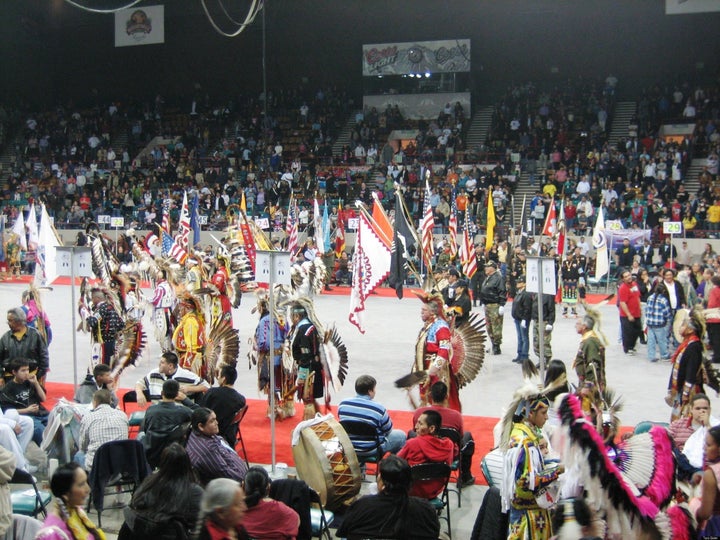
The old saying goes, "If you think you can trust the government, ask an Indian."
Last week marked the 88th anniversary when the United States of America declared Native Americans to be citizens of this country. That's right; it was in 1924 that Indians became U.S. citizens and finally gained the right to vote. Ironically, the white women of America were given the right to vote in August of 1920, four years before Indians were made citizens and gained the same right to vote.
My father, Tim, was 30 years old in 1924 and having been born and raised on the Pine Ridge Indian Reservation in South Dakota, he had never had the right to vote. Now whether he exercised that right in any election after 1924 is debatable. Sometimes it is very hard for one who has been denied certain civil rights to practice those rights once they are given. But I know he spoke very highly of Franklin Delano Roosevelt and like many residents of Pine Ridge he leaned toward the politics of the Democrats simply because of the things he witnessed that they were doing for his people. He saw the construction of the roads, schools and bridges on the reservation under the WPA or Works Projects Administration programs initiated by Roosevelt and he saw for the first time in his life the job opportunities and training provided for Indians by the Civilian Conservation Corps or CCC.
My dad, for most of his early life, was a clerk at different trading posts on the reservation, primarily at Kyle and at Wounded Knee.
Politics has never been far from the minds of most residents of Pine Ridge. My father, whose first language was Lakota, often engaged in political discussions with customers as he waited on them at the trading posts. Local politics never really became externalized until the Indian Re-organization Act was passed in 1934 and Constitutions mimicking those of the United States were drawn up by the different Indian tribes that voted for the IRA forms of government.
In the early days the U.S. government, with very few people to control the large Indian reservations such as the Pine Ridge, had an unwritten law of "divide and rule." Under the traditional form of government the different districts on the reservation were ruled by headmen of the tiospayes, or extended families. Without formal elections on paper the headmen were chosen by their good deeds, wisdom and courage. In order to rule or control, the tiospayes the feds often created hostilities between the different tiospayes and tried to keep them in a state of turmoil.
These internal frictions created by the Indian agents have been passed down through the generations and in some communities they are still prevalent. It lends credence to the old story of two fishermen, one white and one Indian, sitting on a dock. The white fisherman would catch crabs and put them into a bucket, but they would still manage to climb out of the bucket. He noticed that the Indian's crabs stayed in the bucket. He finally asked, "How come the crabs you catch stay in the bucket?" The Indian replied, "Those are Indian crabs; every time one tries to climb up, the other reach up and drag him back down." The success of the "divide and rule" concept still has weight in the minds of some.
I was a speaker at the 20th Anniversary of the SuAnne Big Crow Boys and Girls Club celebration at Pine Ridge on Saturday. I recalled vividly the struggles endured by the founders and current managers of the club, Chick, Cee Cee and Pigeon Big Crow, not only financially, but politically to keep it going these 20 years. They were often the targets of vicious rumors and unfounded gossip by some local residents and getting the financial support from the tribe that the boys and girls of the reservation deserved was often very iffy.
Without the businesses on the reservation to provide summer jobs for the youth, the Boys and Girls Club was a literal lifesaver. It was a safe haven for the kids with nothing to do. And although it did so much good for the children, it still had to fight different factions on the reservation just to survive.
But 20 years later there it stands as a beacon to hard work, perseverance and the tenacity shown by the Big Crow family to keep it alive in the name of SuAnne, a basketball champion and hero to many who was killed in an automobile accident when she was just 17 years old.
And herein stands the reason I mentioned the federal government at the beginning. When many of us from Indian reservations see the United States send billions of dollars in foreign aid to Egypt, Israel, Pakistan, Afghanistan and God knows where else, we often wonder why the indigenous people of America do not come first. Even a simple idea and place like a Boys and Girls Club on an Indian reservation has to sweat blood just to keep its doors open. The SuAnne Big Crow Boys and Girls Club was the first such establishment on an Indian reservation and it led the way so that there are now 200 Boys and Girls Clubs on Indian reservations across America. It took a lot of food people and a lot of donations to make this happen.
If the United States government had used only a fraction of the money it sends out every year in foreign aid to help its own indigenous people, what would life be like on the Indian reservations today? The answer to that is: ask an Indian.
Tim Giago, an Oglala Lakota, was born and educated on the Pine Ridge Indian Reservation. He was founder of the Native American Journalists Association and of Indian Country Today newspaper. He was a Nieman Fellow at Harvard with the Class of 1991.